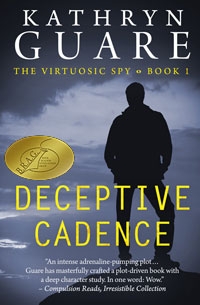Crime Fiction is a popular worldwide and indieBRAG has many great award winning authors who write in this fascinating genre. Today Stephanie talks with B.R.A.G. Medallion Honoree Kathryn Guare who wrote Deceptive Cadence. A story we highly recommend.
Stephanie: When writing crime fiction, there is usually several characters involved. What is your advice in presenting each character so they stand out?
Kathryn: Most of the effort goes into developing the main protagonists, of course, but I think the minor characters are important as well. They offer an opportunity to add layers of color, and the main characters are made richer if they are interacting with something other than cardboard cutouts. When you’ve got a lot of characters, it’s easy to be lazy and pull stock figures from central casting (hairy-chested Russian arms dealer with lots of neck jewelry), but if I spend a little more time on it, I can always come up with a unique and more complicated three-dimensional person that I find more interesting (what if the Russian arms dealer is also a committed yoga practitioner? How would that change his physical appearance, mannerisms and personality?)
Stephanie: I think it is important for writers to give conflicting reasons for their characters to be criminals. For readers to find that connection-if you will-or to perhaps sympathize with them. How do you pull that off and what is your advice on doing so?
Kathryn: It’s important to decide how much sympathy you want to generate for the criminal and build from there. Is this a ruthless person that the reader can’t help but admire a little because of their flair, style, sense of humor? Or maybe this is a criminal by circumstance, someone who had no good choices and got roped into something they can’t get out of, even though it makes them miserable. In either case, the backstory is important. I give all the characters a past and some level of family history. It doesn’t have to included in the story, but it’s in my head so I know when to add something to a scene when I know a character is going to behave or react in a certain way because of the weight of life experience.
Stephanie: Crime Fiction can be difficult to write because it contains many plot-lines. How do you keep track on who has done what and when?
Kathryn: I use various diagrams and flow charts to keep things straight, but as I continue to write, I’ve tried to reduce the number of moving parts in my plots. I’ve found that if I can’t keep track in my own head, the reader won’t be able to, either, and the reader doesn’t want to draw diagrams. My advice is to concentrate on building tension and delivering action without piling on too much complexity.
Stephanie: Crime fiction must be believable. Real-life for the basis of your story is important. How do you corporate this?
Kathryn: If you want to write scenarios that seem plausible, there’s no getting around the research part. Writers have that old joke about what freaks people would think we are if they could see what we Google, but it’s essential, along with other forms of research. But I also realize that my primary mission is to write engaging fiction, not technical manuals. So, although I try not to make stupid mistakes with weapons and such, I leave out the detailed science and “gear” descriptions.
Stephanie: How do you prevent your story from becoming boring?
Kathryn: Related to the issue of believability, I try to make sure that the research serves to inform the story, not strangle it. I have a great group of writing colleagues who read my work and we read our stuff aloud to each other. They are good at pointing out where descriptions start to seem like intentional efforts to insert descriptions, explanations or facts that make it start to sound more like a book report that’s dragging down the momentum.
Stephanie: How should a writer “not” start the opening line to their crime story?
Kathryn: I’m maybe in the minority, but I don’t think there should be any rules about the first line to any story. It is easy to obsess over it, but if you pull a few bestselling crime novels off your shelf I bet you’ll find some first lines are that fairly “meh”, but went on to be brilliant reads. I blogged about this, actually: HERE
Stephanie: What are the key components in writing crime fiction you might not have mentioned above?
Kathryn: In terms of research, I didn’t mention the importance of getting away from the computer for some hands-on research. I don’t write police procedurals, but if I did, I would need to find some way to get close to that process. It’s sometimes important to approach that aspect of your writing as if you were a journalist – interviewing people, getting them to spill secrets, actually visiting the setting (meat-packing plant, police academy, gondola, etc.). That will allow you to add extra ornamentations to descriptions that come from personal observation – particularly smells and sounds.
Stephanie: What are the crime thrillers you read to inspire you?
Kathryn: I gravitate away from heavily plot-driven “ticking clock” thrillers where the characters can barely be seen because they are moving so fast. So, John le Carré is my perennial hero. The stories are so real, the writing beautiful, and the characters have enormous depth and complexity. He takes his time but the tension is always building towards the inevitable sledgehammer scenes.
Also:
Tana French’s Dublin Murder Squad series
Kate Atkinson’s Jackson Brodie series
Dennis Lehane (particularly Shutter Island. Shrieked and threw the book across the room when I got to the climactic scene – never saw it coming!)
For more information about Kathryn check out her website HERE

Leave a Reply